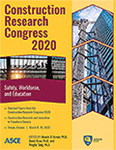Construction Research Congress 2020
Identification of Safety Hazards Using Wearable EEG
Publication: Construction Research Congress 2020: Safety, Workforce, and Education
ABSTRACT
Identifying hazards on construction worksites is a critical component in safety management. Traditional practice relies on the experience and knowledge of safety managers to identify jobsite hazards, which is subjective and leaves many hazards unidentified. A promising alternative is to use wearable biosensors, which can detect physiological responses such as electroencephalogram (EEG), heart rate (HR), and electrodermal activity (EDA) to identify hazards in real time. Since physiological signals from human body show abnormal patterns when a person encounters/perceives a hazard, understanding such patterns may lead to improved detection of jobsite hazards. In this context, this paper examines whether and how the analysis of workers’ emotional responses allows the identification of a safety hazard. The proposed method involves three steps: collecting and preprocessing EEG raw data, measuring workers’ emotional states using a bipolar dimensional emotion model, and establishing the relationship between the workers’ emotional states (e.g., fear, nervous, and displeasure) and the existence of safety hazards. Laboratory experiments are performed to simulate hazards on the jobsite. The results demonstrate the feasibility of utilizing workers’ collective EEG data to identify safety hazards in construction environments, particularly in the context of valence levels.
Get full access to this article
View all available purchase options and get full access to this chapter.
REFERENCE
Albert, A., Hallowell, M. R., and Kleiner, B. M. (2014). “Experimental field testing of a real-time construction hazard identification and transmission technique.” Construction Management and Economics, Taylor & Francis, 32(10), 1000–1016.
Carter, G., and Smith, S. D. (2006). “Safety Hazard Identification on Construction Projects.” Journal of Construction Engineering and Management, American Society of Civil Engineers, 132(2), 197–205.
Chanel, G., Rebetez, C., Bétrancourt, M., and Pun, T. (2011). “Emotion Assessment From Physiological Signals for Adaptation of Game Difficulty.” IEEE Transactions on Systems, Man, and Cybernetics - Part A: Systems and Humans, 41(6), 1052–1063.
Chen, J., Song, X., and Lin, Z. (2016). “Revealing the ‘invisible Gorilla’ in construction: Estimating construction safety through mental workload assessment.” Automation in Construction, Elsevier B.V., 63, 173–183.
Gatti, U. C., Schneider, S., and Migliaccio, G. C. (2014). “Physiological condition monitoring of construction workers.” Automation in Construction, Elsevier, 44, 227–233.
Hamal, A. Q., and bin Abdul Rehman, A. W. (2013). “Artifact Processing of Epileptic EEG Signals: An Overview of Different Types of Artifacts.” 2013 International Conference on Advanced Computer Science Applications and Technologies, IEEE, 358–361.
Hou, X., Liu, Y., Sourina, O., and Mueller-Wittig, W. (2015). “CogniMeter: EEG-based Emotion, Mental Workload and Stress Visual Monitoring.” 2015 International Conference on Cyberworlds (CW), IEEE, 153–160.
Hwang, S., Jebelli, H., Choi, B., Choi, M., and Lee, S. (2018). “Measuring Workers ’ Emotional State during Construction Tasks Using Wearable EEG.” Journal of Construction Engineering and Management, 144(7), 1–13.
Jebelli, H., Ahn, C. R., and Stentz, T. L. (2016). “Fall risk analysis of construction workers using inertial measurement units: Validating the usefulness of the postural stability metrics in construction.” Safety science, Elsevier, 84, 161–170.
Kim, H., Ahn, C. R., and Yang, K. (2016a). “Identifying Safety Hazards Using Collective Bodily Responses of Workers.” Journal of Construction Engineering and Management, 143(2), 04016090.
Kim, K., Cho, Y., and Zhang, S. (2016b). “Integrating work sequences and temporary structures into safety planning: Automated scaffolding-related safety hazard identification and prevention in BIM.” Automation in Construction, Elsevier, 70, 128–142.
Leung, M., Liang, Q., and Chan, I. Y. S. (2016). “Development of a stressors–stress–performance–outcome model for expatriate construction professionals.” Journal of Construction Engineering and Management, American Society of Civil Engineers, 143(5), 4016121.
Li, H., Chan, G., and Skitmore, M. (2012). “Visualizing safety assessment by integrating the use of game technology.” Automation in construction, Elsevier, 22, 498–505.
Min, S. N., Kim, J. Y., and Parnianpour, M. (2014). “The effects of experience and the presence of a scaffold handrail on postural and spinal stability in construction workers.” International Journal of Occupational Safety and Ergonomics, Taylor & Francis, 20(3), 491–502.
Mitropoulos, P., Abdelhamid, T. S., and Howell, G. A. (2005). “Systems Model of Construction Accident Causation.” Journal of Construction Engineering and Management, American Society of Civil Engineers, 131(7), 816–825.
Pinto, A., Nunes, I. L., and Ribeiro, R. A. (2011). “Occupational risk assessment in construction industry - Overview and reflection.” Safety Science, Elsevier, 49(5), 616–624.
Russell, J. A. (1979). “Affective space is bipolar.” Journal of personality and social psychology, American Psychological Association, 37(3), 345.
Slovic, P. (1999). “Trust, emotion, sex, politics, and science: Surveying the risk-assessment battlefield.” Risk analysis, Springer, 19(4), 689–701.
Subasi, A., and Gursoy, M. I. (2010). “EEG signal classification using PCA, ICA, LDA and support vector machines.” Expert systems with applications, Elsevier, 37(12), 8659–8666.
Thammasan, N., Moriyama, K., Fukui, K., and Numao, M. (2017). “Familiarity effects in EEG-based emotion recognition.” Brain informatics, Springer, 4(1), 39–50.
Yang, K., Ahn, C. R., Vuran, M. C., and Kim, H. (2017). “Collective sensing of workers’ gait patterns to identify fall hazards in construction.” Automation in Construction, 82, 166–178.
Zhang, S., Sulankivi, K., Kiviniemi, M., Romo, I., Eastman, C. M., and Teizer, J. (2015). “BIM-based fall hazard identification and prevention in construction safety planning.” Safety science, Elsevier, 72, 31–45.
Information & Authors
Information
Published In
Construction Research Congress 2020: Safety, Workforce, and Education
Pages: 185 - 194
Editors: Mounir El Asmar, Ph.D., Arizona State University, David Grau, Ph.D., Arizona State University, and Pingbo Tang, Ph.D., Arizona State University
ISBN (Online): 978-0-7844-8287-2
Copyright
© 2020 American Society of Civil Engineers.
History
Published online: Nov 9, 2020
Authors
Metrics & Citations
Metrics
Citations
Download citation
If you have the appropriate software installed, you can download article citation data to the citation manager of your choice. Simply select your manager software from the list below and click Download.
